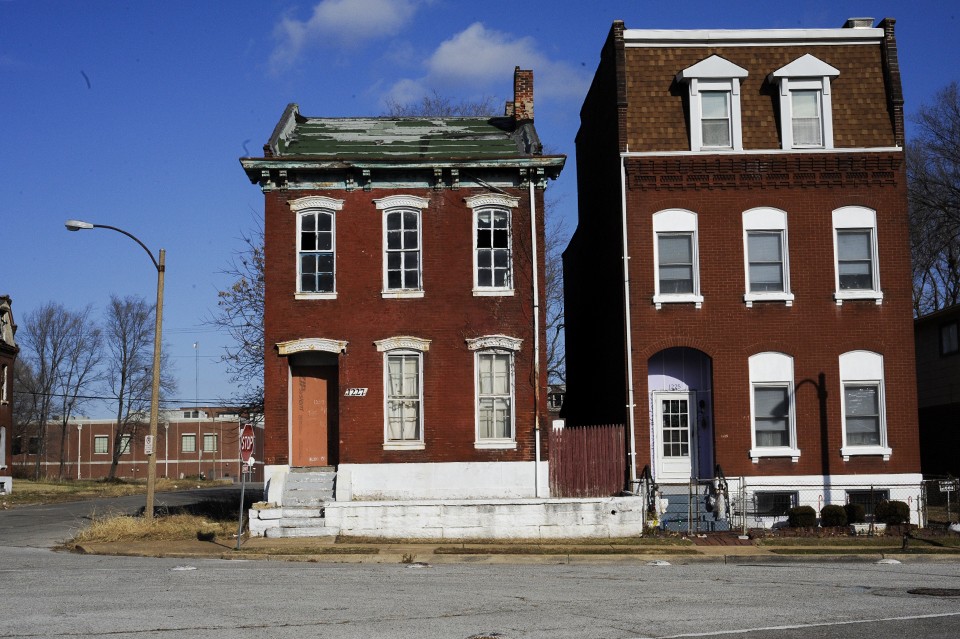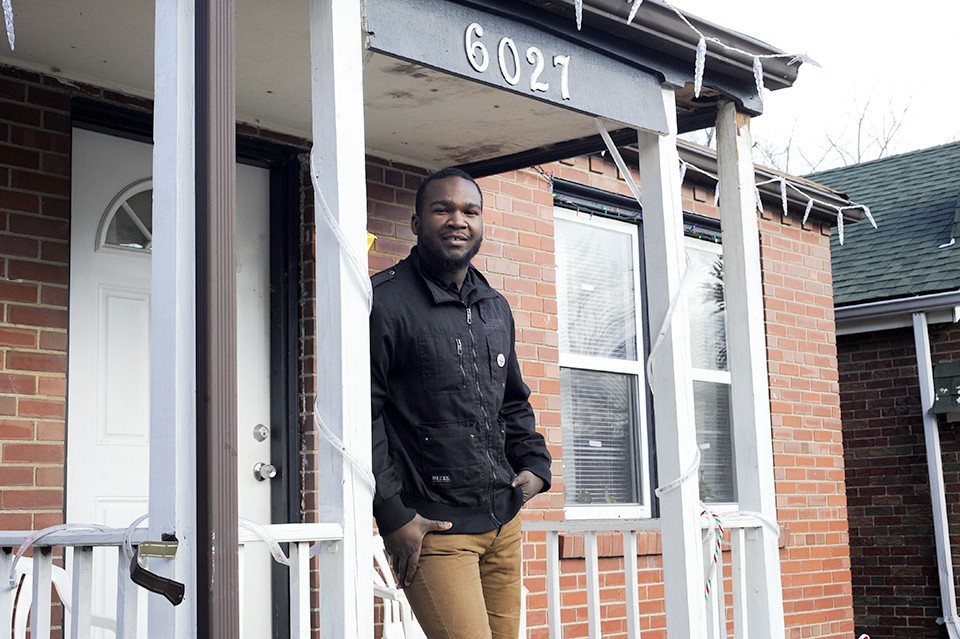Donita Sims' new home has a few problems: The back windows are broken, the top steps leading to the second floor creak and it needs electrical work. Structurally, though, the house is solid, and as a first-time homeowner, Sims couldn't be happier. She bought this home for $1,000.
The house came from the city's land bank — the Land Reutilization Authority, or LRA. If a property doesn't sell at the sheriff's sale, it becomes part of the agency's holdings. Often, that means sitting vacant for years.
But Sims, 21, bought hers before its condition deteriorated beyond repair. The house, located in Walnut Park West in the city's northwestern edge, was vacant only a few years before she purchased it in October.
"I've never really had my own house, or apartment, or anything," Sims says. "I lived with my mom, went to college, came back, lived with my mom. So it's a good feeling to have my own space."
Sims has her friend Eltoreon Hawkins to thank for this. At 24, Hawkins is a part-time student at Harris-Stowe State University and a part-time contractor. He helped Sims find the house and navigate its purchase, and he will do the contracting work at cost. He learned his skills from a combination of working with his uncle, taking construction classes in high school and watching YouTube videos of This Old House.
Hawkins was familiar with the house Sims bought: His family was friends with the previous owner, and the daughter babysat him when he was a toddler. A few years ago, the family lost the place to foreclosure.
"They really kept a nice house," Hawkins says. "Even when I got older and I would come down and bring errands for my mom or I would just step in the doorway and it was still a nice, beautiful house. So that's why I cared about it."
But it's not just this house he cares about. Hawkins is part of the St. Louis Association of Community Organizations, or SLACO — an organization that aims to strengthen St. Louis neighborhoods. The nonprofit formed a "Vacancy Project" two years ago to tackle the problem of empty houses in St. Louis.
A subcommittee narrows the focus even further to vacant houses owned by the LRA. Hawkins and other members drive around St. Louis to find the best homes in the LRA's inventory. Hawkins asks the neighbors which vacant houses in their area they consider the best, inspects the structures and brings those addresses back to the LRA, which has agreed to set them aside for special SLACO outreach events. The goal is to help people who plan to live in these houses acquire them, creating communities in previously blighted neighborhoods. The subcommittee also wants to get the houses back on the tax rolls.
For more than four decades, the LRA has held title to homes and other acreage lost to tax delinquency in St. Louis. It's not an ideal situation. Both the agency and the city of St. Louis spend an enormous amount of money to maintain the holdings. And beyond that is the cost to the neighborhoods that hold them: All those buildings sitting empty can lead to blight and crime and deter other investment.
Efforts to tackle the problem have gained new energy in recent years thanks to a pair of reports that surveyed the work of the LRA and St. Louis' vacancy problem as a whole. Those reports found that the agency engages in virtually no marketing to sell its inventory. It also noted a "perceived lack of transparency reflected in media coverage and community feedback on the LRA."
The LRA's director, Laura Costello, says the authority is taking steps to fix problems outlined in the reports. Mayor Lyda Krewson, who took office in April, has also taken a strong personal interest in making sure reforms are enacted.
But beyond the changes being urged at the agency level, any effort to address the city's glut of vacant homes needs something that may prove even harder to find: Citizens willing to invest not just their money but their sweat in homes and neighborhoods that can seem far from a sure thing. Citizens like Sims and Hawkins.
Even before assisting Sims, Hawkins bought two homes from the LRA in Walnut Park West and renovated both. He was also the first person to complete the city's new Mow-to-Own Program, acquiring a side lot for one of the properties by cutting its grass even before it was in his possession. Hawkins rents out one property and gave the other to his mother, Tryanna Pippens.
"The minute I seen my house up, I wanted it because it was brick," Pippens says. "I'd never been in it. I just knew I wanted it."
Hawkins built his mother a back deck, put a path in the back yard that leads to the house and painted the interior. It is only a couple houses down from the home where she raised Hawkins.
"It was in the same neighborhood and I'm like, well, how can you run from crime?" Pippens says.
"How can you run from drugs? How can you run from this? It's all here, but it takes us to take our neighborhood back, and if we get more young people buying homes instead of vacant buildings, I think we have a great chance of bringing St. Louis back, you know? We need to take charge."
There are about 25,000 vacant or abandoned properties in the city of St. Louis. The LRA currently owns around 11,800 of them.
For the past four decades, the inventory has steadily remained around 11,000, but it ebbs and flows. In 2016, for example, the LRA acquired 499 properties and sold 606. For each of the three years before that, its acquisitions exceeded its sales, a situation Costello blames on the housing crash.
St. Louis used to be on the cutting edge of land-use policy: When the city established the LRA, in 1971, it was the first land bank in the country.
Since then, however, other land banks have been established across the country. The Center for Community Progress estimates that 170 are currently operating in the U.S. And there's increasingly a sense that St. Louis' bank has fallen behind.
"I think there's a failure on our part to keep up with the times," says Alderwoman Cara Spencer. "We were the first land bank in the country. At the time, we were leading the nation and safeguarding the properties, but we have failed to move forward with our land bank, and the world has changed around us. We have not adapted our land-banking strategies, and I think that's a real failure on our part."
For many people interested in the LRA's holdings, acquisitions have proven difficult at best. Just getting started can be hard. LRA does not have its own website, and online instructions for buying from the LRA are scattered under different parts of the city website.
Other complications owe to the nature of dealing with a government agency: Instead of just getting a simple yes or no from a seller, people purchasing from the LRA need the approval of its board of commissioners. And the agency might well insist on the "market rate" for a property, even if the particulars of a given lot don't always bear that out.
Jaymes Dearing owns RE Source, a brokerage firm in Carondelet that specializes in commercial and investment property. He is also the economic development chairman for Carondelet Community Betterment Federation. Dearing began acquiring LRA property about twenty years ago, both for himself as a private investor and professionally for others.
"LRA is difficult to work with," Dearing says. "I know how the system works, but most people I would say fall out of the system before they are able to get what they wanted."
If everything works well, Dearing says, buying a house should take two months maximum. The LRA process, in his experience, can stretch to six. For anyone who needs bank financing, that can be a recipe for frustration.



